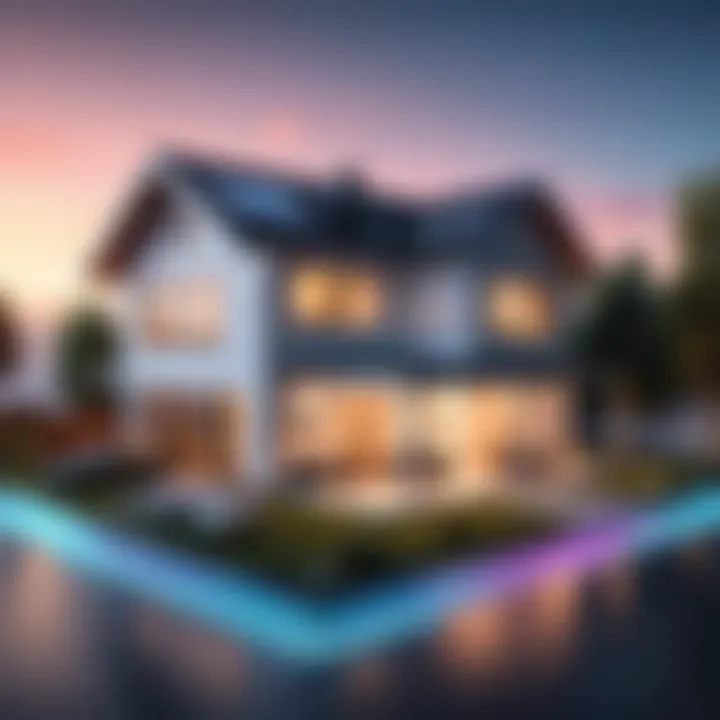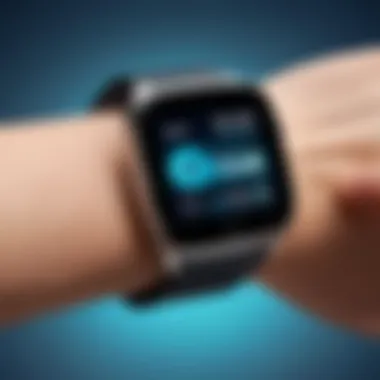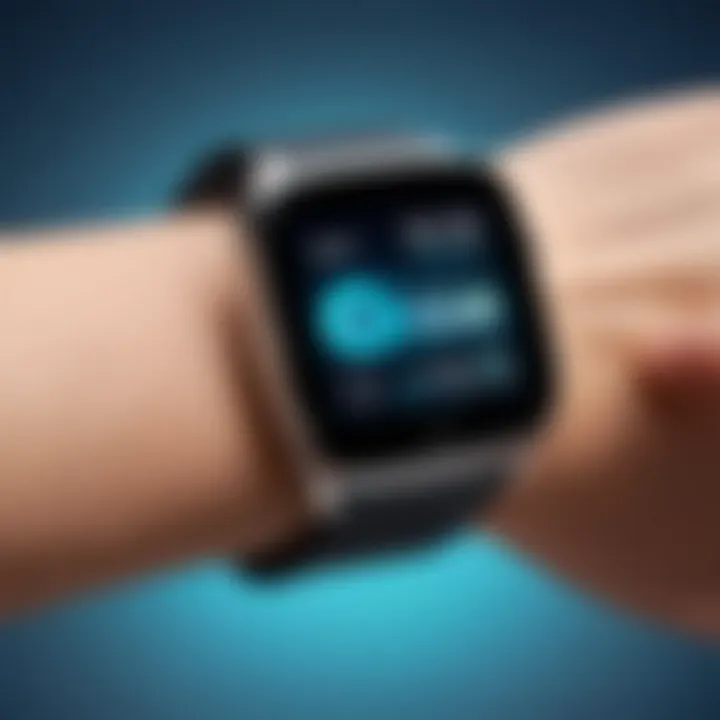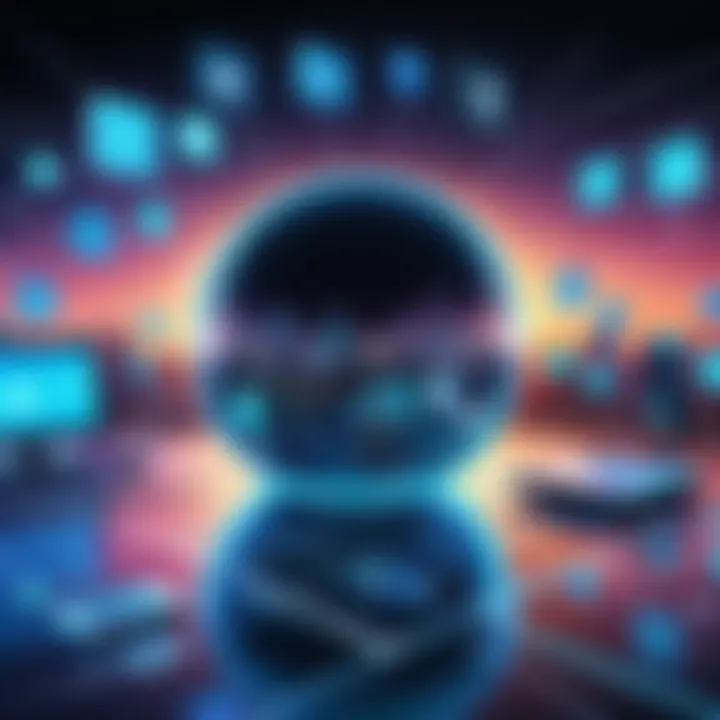Exploring the Diverse World of IoT Devices


Intro
The Internet of Things (IoT) is reshaping how we operate in our personal lives and professional environments. By connecting devices to the internet, IoT allows us to collect and exchange data efficiently. This article dissects the vast ecosystem of IoT devices, categorizing them into smart home technologies, wearables, industrial applications, and others. Understanding the implications of these categories is crucial for both tech professionals and everyday users. As we explore the benefits, risks, and trends of IoT, readers will gain insightful perspectives regarding how these devices transform our interactions with technology.
Overview of Software
Purpose and Use Cases
IoT software acts as a bridge between the physical devices and the user interface. It enables data collection, management, and analysis. Various use cases demonstrate the versatility of IoT software. For example, in smart homes, systems like Google Nest or Amazon Alexa integrate with appliances to enhance convenience. In industrial settings, software such as Siemens MindSphere connects machinery to monitor performance and optimize operations. Wearables utilize software to track health metrics, offering insights for personal wellness.
Key Features
The key features of IoT software typically involve:
- Data Processing: Efficiently collect and analyze data from connected devices.
- User Interfaces: Functionality to allow remote control and monitoring.
- Security Protocols: Safeguarding data against unauthorized access.
- Interoperability: Capability to work across various devices and platforms.
Understanding these features is vital for professionals looking to develop or implement IoT solutions.
In-Depth Review
Performance Analysis
Performance is a crucial aspect of IoT software. It should support high data throughput and low latency to ensure real-time operation. Poor performance can lead to delayed responses and a frustrating user experience. Techniques such as edge computing can enhance performance by processing data closer to the source instead of relying solely on cloud services. An example of effective performance optimization is demonstrated in Microsoft's Azure IoT Suite, which provides tools for real-time analytics and monitoring.
User Interface and Experience
A user-friendly interface is essential in IoT applications. Users should be able to interact with devices effortlessly. Good design often incorporates clear visuals and intuitive controls. Consistent usability across devices is also vital, ensuring that users find it easy whether on a smartphone or a desktop. An example of this can be seen in Apple’s HomeKit, which consolidates various IoT devices into a single, manageable platform.
"The design must not only be aesthetically pleasing but also functional, ensuring users can navigate their IoT ecosystem efficiently."
The intersection of performance and usability defines the user experience in IoT software. By understanding these aspects, professionals can better cater to users’ demands and improve overall satisfaction.
Understanding IoT
The concept of the Internet of Things (IoT) serves as a crucial pillar in contemporary technological advancements. Comprehending IoT is essential not only for software developers and IT professionals, but also for students or anyone engaged in today's rapidly evolving digital landscape. With billions of devices connected, IoT transforms how we interact with our environment, optimize processes, and gather information. Understanding this expansive network empowers individuals to embrace its potential benefits, recognize the associated challenges, and adapt to emerging trends effectively.
Definition of IoT
The Internet of Things (IoT) is a network of interconnected devices that communicate and exchange data over the internet. This includes anything from smart appliances in homes to sophisticated industrial machinery. Devices within the IoT communicate using sensors, software, and other technologies that allow them to collect and exchange data. A practical definition highlights its core function: enabling seamless interactions among devices without human intervention. This interconnectivity yields a wealth of data, leading to automation and efficiency across various applications.
Evolution of IoT Technology
IoT technology has evolved remarkably since its early days. It began with simple machine-to-machine communication, mainly focusing on automating processes in industries. The introduction of RFID (Radio Frequency Identification) tech marked a significant milestone, as it facilitated tracking and inventory management in logistics. Over the years, advancements in cloud computing, data analytics, and wireless technologies have propelled the expansion of IoT.
Today, IoT encompasses diverse fields, including healthcare, agriculture, and smart cities. Innovations like low-power wide-area networks (LPWAN) and 5G connectivity have further enhanced the capabilities and application of IoT devices. This evolution continues to shape how businesses operate, influencing everything from supply chain management to personal lifestyle integrations.
Core Components of IoT
To grasp the full scope of IoT, it's vital to understand its core components:
- Devices and Sensors: These are the physical objects that collect data. They can range from smart thermostats to industrial sensors.
- Connectivity: Reliable network technology, whether cellular, Wi-Fi, or LPWAN, is essential for devices to communicate.
- Data Processing: Collected data is analyzed, often in real-time, to extract insights and drive decisions.
- User Interface: This component allows users to interact with the system, whether through a mobile app or a web-based dashboard.
These core elements come together to create a cohesive IoT ecosystem, facilitating automation and enhancing operational efficiency across multiple sectors.
"Understanding the core components of IoT is not just beneficial, but essential for anyone looking to harness the power of connected devices for personal or corporate use."
Categories of IoT Devices
The landscape of IoT devices is broad and varied, making the categorization of these devices essential for understanding their functions and contributions to the interconnected world. This article discusses several types of IoT devices, ranging from smart home technology to industrial and agricultural applications. By identifying specific categories, readers can better grasp how various devices affect everyday life, industry efficiency, and overall connectivity.
Smart Home Devices
Smart home devices encompass a variety of products designed to enhance convenience, security, and energy efficiency. They allow homeowners to control different aspects of their living environment remotely. As urbanization increases, the demand for streamlined home management grows, making these devices more than just luxury items.
Smart Thermostats
Smart thermostats optimize heating and cooling in buildings. They learn user habits and can adjust temperatures automatically. This adjustment leads to energy savings and enhanced comfort.
A key characteristic of smart thermostats is their ability to connect to Wi-Fi, enabling remote control via mobile apps. This capability makes them a popular choice among homeowners. A unique feature in models like the Nest Learning Thermostat is its learning functionality. It observes the temperature preferences of users and adapts accordingly, which can result in significant energy savings. The downside, however, includes the initial cost and the need for reliable internet access.
Smart Locks
Smart locks provide an elevated level of security for homes. They offer keyless entry and remote access, which enhances peace of mind for users. The key characteristic lies in their integration with smartphones, allowing users to lock or unlock doors from anywhere.
Devices like August Smart Lock enable users to grant temporary access to visitors without the need for physical keys. This is a beneficial feature for homeowners who frequently have guests. However, concerns exist regarding security vulnerabilities inherent in digital locks, making it crucial for users to stay informed about updates and best practices.
Smart Lighting
Smart lighting systems allow users to control illumination remotely and automate lighting schedules. They contribute to security by simulating occupancy when users are away. A prominent feature is the ability to change colors and adjust brightness through apps or voice commands.
Philips Hue lights are well-known for their versatility and easy integration with smart home assistants. This adaptability makes smart lighting very appealing. One downside is the continuous need for power and the possibility of dependency on Wi-Fi, which can lead to disruptions in case of connectivity issues.


Wearable Technology
Wearable technology includes devices that can be worn on the body, tracking various metrics and providing valuable data. This category is rapidly growing, with potential to influence health and lifestyle significantly.
Fitness Trackers
Fitness trackers monitor physical activity, heart rate, and sleep patterns. This data empowers users to achieve fitness goals. Their main appeal lies in their convenience and accuracy in tracking metrics that are personalized to the user.
A key feature found in Fitbit devices is their ability to sync data to a smartphone app, offering insights into user habits. These trackers are beneficial for users looking to improve their health. However, privacy concerns arise with the data collected, prompting discussions about how that data is used and stored.
Smartwatches
Smartwatches extend the functions of traditional watches by including notifications, health tracking, and app integration. Their appeal lies in their ability to provide quick access to information without needing to check a phone.
Devices like the Apple Watch provide comprehensive health monitoring, including ECG capabilities and fall detection. While they are popular for their functionality, the dependencies created can lead to users feeling overwhelmed by notifications.
Health Monitors
Health monitors go beyond simple fitness tracking. They help in the continuous monitoring of vital signs such as glucose levels, blood pressure, and heart rhythms. These devices are pivotal for patients needing regular check-ups.
The unique advantage of devices like continuous glucose monitors is real-time data transmission to both users and healthcare providers. This immediate access can lead to timely interventions. However, users may face challenges with the accuracy of readings and compatibility with health systems.
Industrial IoT Devices
Industrial IoT devices are essential for automating and streamlining processes in manufacturing and other sectors. They improve productivity and reduce operational costs through data collection and analysis.
Sensors
Sensors are at the core of industrial IoT. They gather data from machinery and the environment, enabling real-time monitoring. The primary characteristic is their ability to provide critical insights that can preemptively address issues.
For instance, temperature and humidity sensors can prevent equipment failure. However, their reliance on proper installation and maintenance can introduce challenges. Missing or faulty sensors may lead to inaccurate data collection.
Automated Machinery
Automated machinery uses IoT technology to function without constant human oversight. It is involved in manufacturing, packaging, and logistics. A key characteristic is the integration of AI with machine operations, allowing for predictive maintenance.
Machines like robotic arms in assembly lines can increase efficiency but may incur high installation costs. Another consideration is the potential need for skilled staff to oversee more complex systems.
Asset Trackers
Asset trackers monitor the location and condition of physical assets. They contribute greatly to supply chain efficiency by minimizing loss and maximizing efficiency. A prominent feature is GPS integration for real-time tracking.
Devices like Tile offer low-cost solutions to keep tabs on belongings. While this is beneficial for inventory management, devices might not be immune to technical failures or range limitations.
Healthcare IoT Solutions
The healthcare sector is increasingly adopting IoT for better patient outcomes and more efficient hospital operations. Medical devices connected to the internet enable continuous patient monitoring.
Remote Patient Monitoring
Remote patient monitoring systems enable healthcare providers to track patients' health outside traditional settings. Their greatest strength is reducing the need for hospital visits, saving time and resources.
A key characteristic of these systems is the ability to send alerts for concerning health metrics directly to clinicians. Devices such as the AliveCor KardiaMobile exemplify these benefits. However, concerns about data privacy can present obstacles to widespread adoption.
Smart Medical Devices
Smart medical devices collect and transmit health data for analysis. They bridge the gap between patients and doctors, enhancing treatment approaches. A notable feature may include medication management reminders or real-time data sharing.
Devices like the Omron blood pressure monitor have gained attention for their ease of use and effective data collection. Nevertheless, some patients may struggle to adapt to this technology and may require guidance.
IoT in Drug Delivery
IoT in drug delivery systems improves the efficiency and accuracy of administering medication. Automated dispensers can enhance compliance by reminding patients when to take their medication. The unique advantage is the integration with apps for real-time tracking.
Devices such as the MedaCube offer a robust solution to manage medication for complex treatment protocols. However, challenges include dependency on technology and possible medication errors if the system malfunctions.
Agricultural IoT Instruments
Agricultural IoT devices help farmers optimize their operations through data analytics. They provide insights that lead to more sustainable practices and improved yields.
Soil Sensors
Soil sensors measure moisture, temperature, and nutrient levels. This data allows farmers to make informed decisions about irrigation and fertilization. Their key characteristic is the precision they bring to agricultural practices.
Devices like the Vegetronix V00 provide real-time soil moisture readings. The downside involves the potential for device failure in complex soil conditions, leading to inaccurate readings.
Weather Stations
Weather stations equipped with IoT technology provide localized weather data crucial for farming decisions. Their primary function is to gather data on rainfall, temperature, and humidity.
Devices such as Davis Vantage Pro2 give accurate insights into weather patterns. Yet farmers must consider the costs of installation and maintenance, which might be prohibitive in some regions.
Automated Irrigation


Automated irrigation systems use data from various sensors to optimize water usage in farming. The main benefit is improved resource management, conserving water in the process.
Smart irrigation systems like the Rachio Smart Sprinkler Controller adapt based on weather forecasts and soil moisture levels. However, reliance on technology might leave farmers vulnerable in cases of connectivity issues.
Smart City Technologies
Smart city technologies rely on IoT to improve urban life. These devices enhance infrastructure efficiency and improve the quality of life for residents.
Traffic Management Systems
Traffic management systems use IoT to optimize the flow of vehicles in urban areas. These systems monitor traffic patterns and make real-time adjustments to traffic signals. A key characteristic is their ability to reduce congestion and improve travel times.
Devices such as Siemens’ smart traffic signals exemplify this approach. However, coordination between various systems can pose challenges.
Smart Waste Management
Smart waste management employs IoT to optimize collection routes and schedules. The main advantage is enhanced efficiency and decreased operational costs for municipalities.
Devices like Bigbelly use smart sensors to notify waste collection teams when bins are full. Yet, challenges include the initial investment budget that municipalities may find restrictive.
Public Safety IoT Devices
Public safety IoT devices monitor a range of factors to enhance community security. They include surveillance cameras and environmental sensors. A critical aspect is real-time data transmission to emergency services.
Products like ShotSpotter help law enforcement pinpoint shooting incidents. However, the use of such technologies raises concerns about privacy and data handling practices.
Applications of IoT Devices
The Internet of Things (IoT) has transformative potential in various sectors. Its applications extend beyond mere connectivity, influencing how industries operate and how individuals manage their daily lives. The significance of IoT applications lies in their ability to enhance efficiency, improve data analysis and provide innovative solutions to complex problems. Businesses and consumers alike can benefit from these advancements. There are numerous applications, each presenting unique advantages and considerations that merit exploration.
Home Automation
Home automation epitomizes the consumer-friendly side of IoT. Devices like smart thermostats, locks, and lights allow homeowners to control their environments with convenience and efficiency. Smart thermostats, such as the Nest Learning Thermostat, adapt to user habits and optimize energy consumption. Smart locks enhance security through remote access control and logging of entries. Smart lighting systems, like Philips Hue, enable users to customize their lighting based on personal preference and time of day. This not only improves comfort but also contributes to energy savings.
The growing trend in home automation signifies an increased interest in sustainable living. By leveraging IoT devices for automation, individuals can monitor their energy usage and adjust accordingly. This reinforces the notion that technology can aid in reducing carbon footprints. However, considerations around security and compatibility remain pivotal. Homeowners must be diligent when selecting devices to ensure they integrate smoothly and do not compromise security.
Health Monitoring
Health monitoring is another significant application of IoT, centered around enhancing personal health management. Devices such as wearable fitness trackers—Fitbit and Apple Watch—collect health data, including heart rate and activity levels. This data can be processed to inform users about their health status and encourage healthier lifestyle choices. Moreover, more advanced devices, like remote patient monitoring systems, allow healthcare professionals to track patients’ conditions from a distance. This is particularly beneficial for chronic disease management, providing continuous data analytics to improve care.
Data privacy and security remain major challenges in this domain. Users should be aware of who has access to their data and how it is utilized. Furthermore, healthcare providers must comply with regulations like HIPAA to secure sensitive information. Overall, health monitoring through IoT devices enhances patient engagement and potentially improves health outcomes by facilitating timely interventions.
Supply Chain Management
In the realm of supply chain management, IoT devices are revolutionizing how businesses track and manage logistics. Sensors can monitor the status of goods as they move through the supply chain, ensuring that products are stored and shipped under optimal conditions. Companies like IBM employ blockchain technologies in conjunction with IoT to improve transparency and traceability.
Additionally, IoT devices can provide real-time data on inventory levels. This is crucial for demand forecasting and inventory management. The efficiency brought by IoT leads to reduced operational costs and optimized resource utilization, enhancing the overall productivity of the supply chain.
Energy Management
The role of IoT in energy management cannot be understated. Smart grids are being developed to improve the efficiency of electricity distribution. For example, devices that monitor energy consumption in real-time allow users to make informed decisions about their usage. Companies are investing in software that analyzes this data to identify trends and provide actionable insights.
In commercial buildings, IoT systems can control heating, cooling, and lighting to optimize energy use. This results in significant cost savings and reduced environmental impact. As cities move towards smarter infrastructures, embracing IoT for energy management becomes essential for sustainability goals.
Environmental Monitoring
Environmental monitoring is a vital application of IoT that focuses on collecting data about our surroundings. Devices can monitor air quality, water quality, and even soil conditions, facilitating early detection of environmental changes. Cities use IoT sensors to track pollution levels, contributing to better public policy decisions regarding environmental health.
Furthermore, agricultural IoT solutions can help farmers optimize resource use by providing real-time data regarding soil moisture and weather conditions. This targeted approach not only conserves water but also increases crop yields. By integrating IoT into environmental efforts, communities can work towards more sustainable practices, demonstrating a commitment to ecological preservation.
"The applications of IoT span various sectors, and their impact on efficiency and sustainability cannot be ignored."
Benefits of IoT Devices
The benefits of IoT devices are numerous, touching various aspects of daily business operations and individual lifestyle choices. As organizations adopt IoT technologies, they often notice significant improvements in their processes and efficiencies. This section discusses crucial elements concerning the benefits of IoT devices, including increased efficiency, enhanced data collection, improved decision-making, and cost reduction.
Increased Efficiency
One of the most notable advantages of IoT devices is heightened efficiency. By automating repetitive tasks through connected devices, organizations can streamline operations. For example, in manufacturing, IoT sensors can monitor machinery conditions in real-time. This proactive approach helps in preventing breakdowns, thereby increasing the uptime of machinery. In the realm of logistics, real-time tracking of shipments enhances warehouse operations, minimizes delays, and optimizes delivery routes. Efficient operations free up resources and allow staff to focus on more intricate tasks that require human intervention.
Enhanced Data Collection
IoT devices excel in collecting data from various sources. This information is critical for businesses that rely on accurate data for their strategies and decision-making. Sensors in smart devices capture data about usage patterns, environmental factors, and user behaviors. Smart thermostats, for instance, can analyze heating and cooling patterns to optimize energy consumption. This data-driven approach enables businesses to tailor their services to meet customer expectations and improve their products continuously. By integrating these advanced data collection methods, companies can anticipate market trends and customer preferences more effectively.
Improved Decision Making
With enhanced data collection, the decision-making process is transformed significantly. Organizations can now make informed decisions based on real-time analytics provided by IoT devices. Instead of relying on static reports, managers have access to ongoing performance metrics. This shift allows for quicker adjustments and adaptations to market changes. For instance, retail businesses can monitor foot traffic and customer interaction in stores through smart cameras, which leads to more strategic in-store marketing techniques and inventory management.
Cost Reduction
Incorporating IoT devices can lead to substantial cost reductions. By optimizing resource usage and minimizing waste, companies can save on operational costs. For example, smart lighting systems adjust based on occupancy and natural light levels, significantly reducing electricity bills. In addition, predictive maintenance driven by IoT devices helps avoid costly repairs and extends the lifespan of equipment. Moreover, automating routine processes cuts down labor costs, as machines can handle simple tasks without human oversight.


"The integration of IoT solutions empowers businesses to operate at a level that was previously unattainable, fostering growth while minimizing both operational costs and resource waste."
In summary, the benefits of IoT devices extend beyond mere convenience. Increased efficiency, enhanced data collection, improved decision-making, and cost reduction are fundamental aspects that define how organizations transform their operations in the modern technological landscape. Through thoughtful implementation of IoT technologies, both businesses and individuals can realize profound and impactful benefits.
Challenges in IoT Implementation
The growing adoption of Internet of Things (IoT) devices brings about significant opportunities and benefits. However, with these advancements come various challenges that impact implementation. Understanding these issues is crucial for both developers and businesses to ensure the successful integration of IoT solutions. This section explores several key challenges in IoT implementation, focusing on their implications and the strategies that can be employed to address them.
Security Concerns
Security is perhaps the most pressing challenge in the IoT landscape. As more devices connect to the Internet, they become potential targets for cyberattacks. Each device introduces vulnerabilities that can be exploited. For instance, weak passwords and outdated firmware are common issues. The consequences of security breaches can be severe, leading to data theft, loss of privacy, and financial damages.
Implementing strong security protocols is essential. This includes:
- Regular software updates to patch vulnerabilities.
- Encryption of data to protect information during transmission.
- User authentication protocols to restrict access to devices.
Investing in robust security measures is not an option but a necessity for businesses and individuals.
Interoperability Issues
Another significant challenge is the interoperability of devices. The IoT ecosystem comprises numerous manufacturers and standards, causing compatibility issues. A smart home, for example, may include devices from different brands that do not communicate effectively with each other. This fragmentation hinders users from fully utilizing their devices.
To tackle interoperability issues, organizations can:
- Follow established standards such as MQTT or CoAP for communication.
- Collaborate with other manufacturers for better integration.
- Develop middleware solutions to bridge gaps between different devices.
Privacy Considerations
Privacy is a paramount issue when implementing IoT devices. The continuous data collection from various sensors can lead to unauthorized access to personal information. Users often do not realize how much data they share and how it is used. For instance, fitness trackers may collect sensitive health information that, if mishandled, could lead to privacy violations.
To enhance privacy, manufacturers should:
- Provide clear privacy policies that inform users how their data will be used.
- Implement opt-in mechanisms whereby users willingly agree to data collection.
- Employ anonymization techniques to protect user identity.
Scalability Challenges
Scalability involves the ability of IoT systems to handle increased loads or device additions without degrading performance. As businesses grow and adopt more devices, they may face challenges in managing an increased volume of data and connections. An unscalable system can lead to slow response times and system failures, which hinder user experience.
To ensure scalability, developers should:
- Design systems with modular architectures that can accommodate growth.
- Utilize cloud services to manage data storage and processing effectively.
- Optimize network infrastructure to handle a larger number of connections.
Future Trends in IoT
The landscape of the Internet of Things is constantly evolving. As technology progresses, it shapes the future trends that can influence how IoT devices function and interact. Understanding these trends is essential for industry professionals, software developers, and students keen on this technology. These trends not only impact the functionality of devices but also redefine user experiences and operational efficiencies across sectors.
Edge Computing
Edge computing is a pivotal trend for the future of IoT. Instead of relying on a central server, data processing occurs at the edge of the network, where the data is generated. This approach reduces latency significantly. For example, smart devices in a manufacturing line can communicate efficiently without sending all data to the cloud for processing. Thus, immediate decisions can be made, enhancing time-sensitive operations.
Moreover, edge computing enhances privacy and security. By keeping sensitive data localized, the exposure to central server breaches diminishes. This trend aligns well with increasing demands for data protection across various industries. As organizations seek to leverage real-time data, the importance of edge computing in IoT architectures cannot be overstated.
Integration with AI
The integration of Artificial Intelligence with IoT devices represents another forward-looking trend. AI algorithms can analyze the vast amounts of data collected by IoT devices. This analysis allows for intelligent decision-making and predictive analytics. For instance, smart appliances can learn user habits and optimize energy consumption accordingly. This integration is essential for creating smart environments that respond intuitively to user needs.
Furthermore, AI significantly enhances the functionality of IoT devices in sectors such as healthcare and agriculture. In healthcare, AI can track health metrics and predict potential health issues. In agriculture, it allows for optimized planting schedules based on weather patterns analyzed from IoT devices. Ultimately, AI strengthens the capability and efficiency of IoT devices, making them more valuable in any sector they are applied.
5G and IoT
The arrival of 5G technology is poised to further bolster IoT connectivity. The increased bandwidth and reduced latency offered by 5G networks facilitate the connection of a larger number of devices without sacrificing speed. This capability allows for a more extensive deployment of smart devices across a multitude of applications. For instance, autonomous vehicles require rapid data exchange for navigation and safety. With 5G, these devices can interact efficiently in real-time, leading to safer road systems.
Additionally, 5G enhances the functionality of existing devices. Smart cities can better manage resources such as traffic flow and energy consumption when connected to a robust 5G network. The potential for innovation in transport, healthcare, and residential applications becomes vast with this technology.
Sustainability in IoT
Sustainability has become a critical aspect in the design and operation of IoT devices. As environmental concerns grow, developers are increasingly focused on creating energy-efficient devices with minimal ecological impact. IoT enables organizations to monitor and optimize resource usage in real-time, leading to more sustainable practices.
For example, smart energy meters help consumers reduce energy waste by providing insights into their usage patterns. In agriculture, IoT devices can monitor soil moisture levels and automate irrigation, conserving water and reducing energy expenditures.
Moreover, as companies adopt more sustainable practices, they can also enhance their brand image and appeal to eco-conscious consumers. The push for sustainability in IoT is not just a trend but a necessity in today's world.
"The convergence of IoT and sustainability is reshaping how industries operate, fostering a future where innovation meets environmental responsibility."
Culmination
The conclusion of this article serves to encapsulate the extensive discussions surrounding IoT devices. It is essential because it summarizes the key points made throughout the article, reinforcing the critical aspects of IoT technology. The insights gained from the various sections help to solidify understanding of the vast potential and implications of these devices.
Recap of Key Points
In this article, we delved into several core aspects of IoT devices. We examined their diverse categories, ranging from smart home devices to industrial IoT solutions. Each category presents unique features and applications. The benefits provided by these devices include increased efficiency, enhanced data collection, and improved decision-making. Challenges such as security concerns and interoperability issues were also discussed. Finally, we considered future trends in the IoT landscape, highlighting the role of edge computing and the integration with AI technology.
Implications for Consumers and Industries
The implications of IoT devices are profound for both consumers and industries. For consumers, IoT devices offer convenience and enhanced control over various aspects of daily life. From smart thermostats to wearable health monitors, users can tailor their environments to suit personal preferences.
For industries, the impact of IoT technology can lead to streamlined operations, cost savings, and improved understanding of consumer behavior. Businesses can harness data collected from IoT devices to make informed decisions that can drive growth and innovation. Hence, the growing adoption of IoT technology is likely to transform business models and enhance productivity across different sectors.
The integration of IoT devices is not just a trend; it is a fundamental shift in how we interact with technology and manage our environment.







